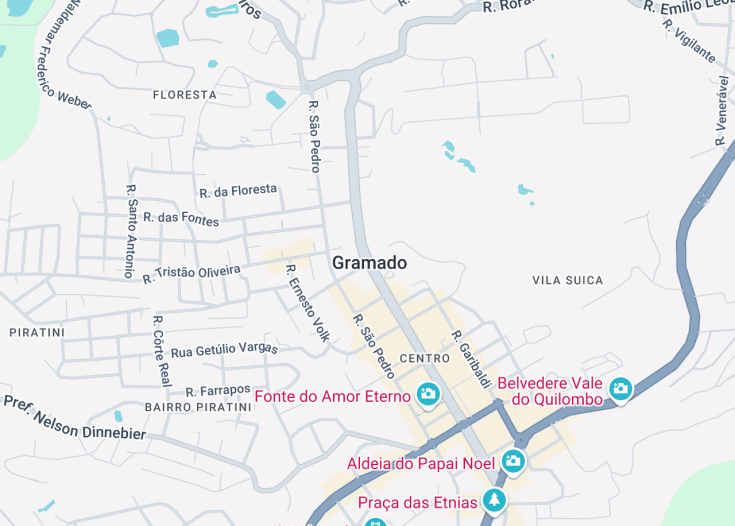Nestled amidst the Serra Gaúcha in Brazil, Gramado offers a unique fusion of Brazilian warmth with European flair. Known for its Bavarian-styled architecture, enchanting gardens, and fine chocolate, it stands as a testament to its Swiss and German roots.
Visitors are drawn to its festive Christmas light displays and the renowned Festival de Cinema de Gramado. The city’s alpine landscapes and temperate climate add to its allure, making it a picturesque escape from the bustling urban centers.
To best experience Gramado, consider visiting during the winter when the town comes alive with festivals and the cool climate enhances the European ambiance.
Don’t miss a visit to Lago Negro for a scenic walk or paddleboat ride, especially during sunrise or sunset, which offers breathtaking views and photo opportunities.
Gramado: A Slice of Europe in Brazil
| Country | Brazil |
| Time in Gramado | GMT-3 |
| Language spoken | Portuguese |
| Population | 36,500 (Source: IBGE 2022) |
| Currency | Brazilian Real (R$ / BRL) |
| Airports |
|
Located in the southern state of Rio Grande do Sul, Gramado is a charming town that emulates a European atmosphere with its alpine architecture and lush green landscapes. Known for its chocolate boutiques, artisan wares, and colorful seasonal festivals such as the Film Festival and Natal Luz, the town proudly stands as a premier tourist destination in Brazil.
Often draped in a cool climate that contrasts with much of tropical Brazil, Gramado offers a unique experience with quaint streets lined with hydrangeas, small bridges, and waterways that enhance its picturesque setting.
Where is Gramado?
Gramado is nestled in the Serra Gaúcha region of Rio Grande do Sul, Brazil, offering scenic views and a robust local culture reminiscent of European countryside towns.
Distances:
| Route | Distance by car | Time by car |
|---|---|---|
| Porto Alegre to Gramado | Porto Alegre to Gramado | Approximately 2 hours |
| Florianópolis to Gramado | 300 miles (482 km) | Approximately 6 hours |
What is Gramado famous for?
Gramado is famous for its enchanting natural beauty, captivating seasonal festivals, and rich European heritage. Its distinctive European-flavored architecture and gastronomy attract visitors from all over the country and the world, making it a cultural hub in Brazil.
History
Early Settlements to Late 19th Century
The region of Gramado, now known as a picturesque destination in Brazil’s Rio Grande do Sul, originally was inhabited by indigenous people, primarily the Tupi-Guarani. The natural beauty of the area, characterized by dense forests and rolling hills, remained largely undisturbed until the arrival of Portuguese colonizers and, later, significant numbers of German and Italian immigrants in the late 19th century, who embedded their unique cultural imprints on the town.
20th Century Development
Gramado’s transformation into a town was officially marked in 1913, influenced heavily by the influx of European culture and architecture. Throughout the 20th century, Gramado evolved from a small village into a renowned tourist destination. The establishment of stone-cobbled streets, Bavarian-style buildings, and blooming hydrangeas alongside methods from their European ancestry helped shape its unique appeal. The town also saw a growth in craftsmanship and furniture making which further boosted its local economy and tourism sector.
Modern Era
Today, Gramado is recognized not only for its enchanting European-style streetscapes but also for its modern amenities and robust events like the Gramado Film Festival, which attracts visitors from across the globe. The combination of historical heritage with contemporary culture ensures that Gramado retains its charm while continuously adapting to the changing preferences of tourists.
Visit Gramado
What to see and do in Gramado
Gramado offers a plethora of attractions that cater to all ages and interests. Visitors can explore the charming streets like Rua Coberta, adorned with boutiques and cafes.
Gramado also boasts stunning natural parks such as Lago Negro, with its serene lake surrounded by lush forests ideal for picnics and boat rides. For culture enthusiasts, Gramado hosts the annual Film Festival that celebrates both Brazilian and international cinema.
- Stroll through Mini Mundo, a miniature park that displays replicas of famous global landmarks.
- Visit the Snowland, the first indoor snow park in the Americas, offering various snow activities.
- Relax at Lago Joaquina Rita Bier, beautifully landscaped and perfect for evening strolls.
Festivals and Events in Gramado
Gramado is renowned for its vibrant cultural scene, particularly evident during its annual events. The Gramado Film Festival, held in August, showcases films from various countries and draws cinephiles worldwide.
The town also celebrates Natal Luz, a spectacular Christmas light event from October to January, transforming the town into a festive wonderland.
Best time to visit Gramado
The ideal period to visit Gramado is between March and May or from August to October when the weather is milder, and the town hosts significant cultural activities that heighten the overall experience.
Is Gramado worth visiting?
Certainly, Gramado is well worth a visit. With its European-flavored charm, diverse cultural attractions, and a range of natural landscapes, Gramado offers a unique experience that differentiates it from other tourist destinations in Brazil.
The town’s capability to blend its rich history with modern-day tourism appeals significantly to those seeking both relaxation and cultural enrichment.









